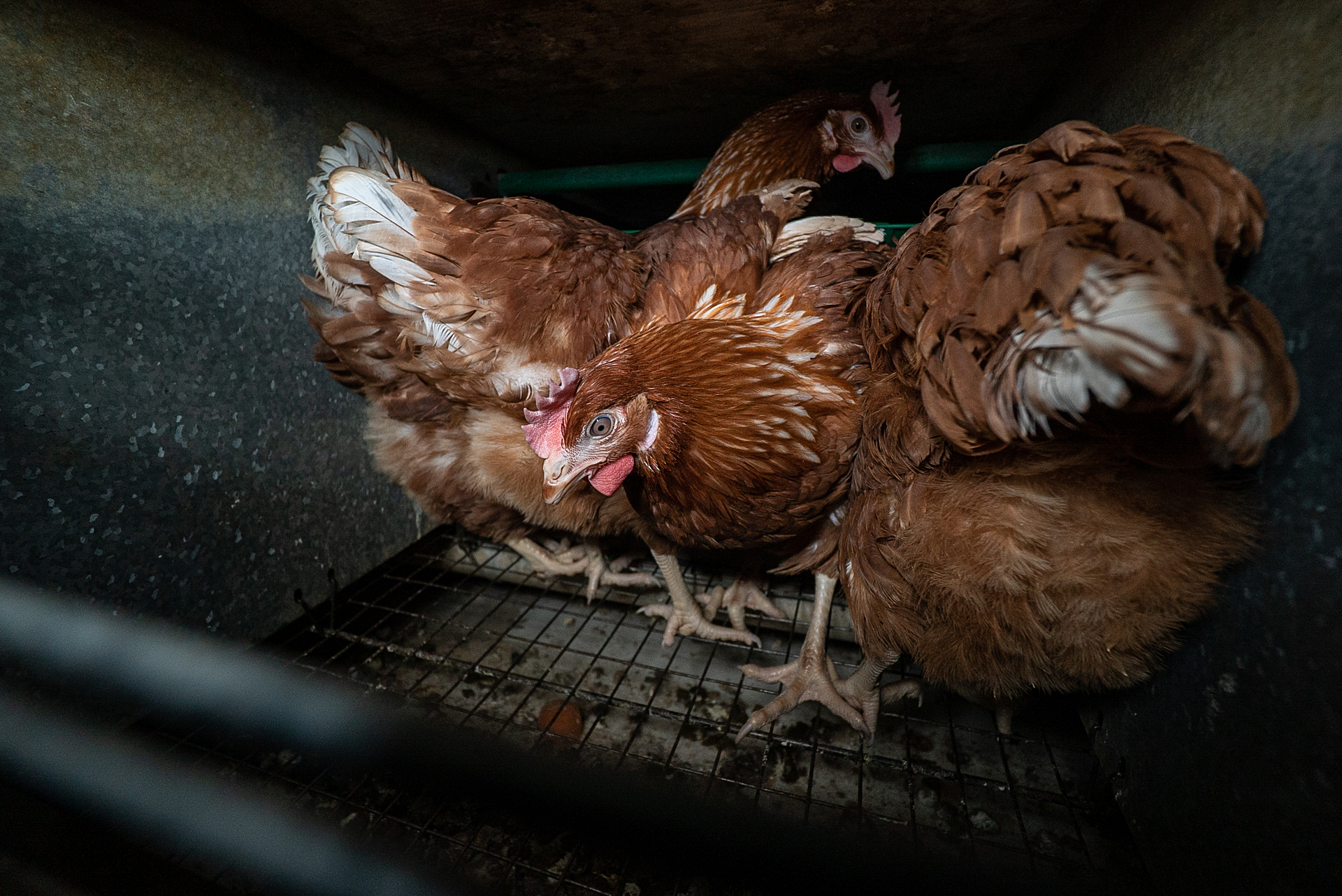Celebrating the Night Gardeners of our Eco-System! Australia is home to over 90 species of bats, each playing a critical role in our ecosystems. From pollinating native flora to foraging on insects, these remarkable creatures help keep our landscapes healthy, diverse and in balance. On International Bat Day, Humane World...
Unfortunately, wombats are one of the top species impacted by animal-vehicle collisions in Australia. Car strikes are also one of the leading reasons that wombats are rescued. It is a common enough story: a pouch check of a road-struck female wombat reveals a vulnerable joey needing specialised care which is then brought to a wombat rehabilitator.
But do you know how much care goes into these wombat joeys from rescue to release?
It can take up to TWO years from the rescue of a wombat joey to their release. This time frame mirrors the time that young wombats spend under the care of their mother.
Caring for a wombat is no easy feat, nor for the faint-hearted.
Rehabilitating orphaned joeys involves incredible dedication and around-the-clock work by carers. Without this support, these joeys would likely perish if they were left to fend for themselves.
Members of the Humane Society International Australia’s private land conservation program the Wildlife Land Trust include wombat carers at sanctuaries: Wombat Stomp, Edala, Docsden and Sleepy Burrows. These members are representative of a wider network of carers who selflessly devote their lives to caring for this unique and charming Australian animal. Read on to learn more about how carers help assist joeys through their journey from rescue to release.
Five stages of wombat care after rescue
1. Immediate treatment
After an initial assessment by a veterinarian or experienced qualified rehabilitator, a wombat joey can begin their journey in care. There may be a period of intensive care and treatment when a joey arrives with a carer, depending on the joey’s age and condition i.e. if they have any injuries or illnesses.
As well as any medical treatment, the priorities at this stage are hydrating and feeding the joey and keeping it warm. If joeys are at the dependent pouch stage, they will require frequent bottle feeding and will be given supplemental heat and kept in a fabric pouch or humidicrib to keep toasty warm as they may be furless and not able to regulate their body temperature themselves. Some of the joeys at the youngest ‘pinkie stage’ may be as light as 100–200g.

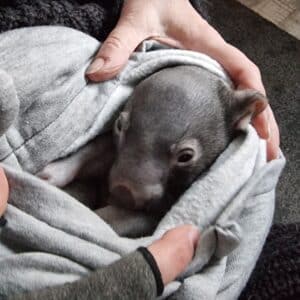
Left: ‘Pinkie stage’ joey Maxi at Wildlife Land Trust Sanctuary Edala., Photo credits Sam Edmonds,
Right: Newly furred joey Gilbert at Wildlife Land Trust sanctuary Wombat Stomp
2. Buddying-up
As a wombat joey ages and reaches the 2–3kg mark they will need constant companionship. At this stage having a wombat “buddy” helps them learn how to “be a wombat”. Pairing with another wombat at a similar stage of development or weight will aid their learning of normal wombat behaviours and minimise stress. Buddying also prevents joeys from imprinting on human carers which could affect their later success at release.
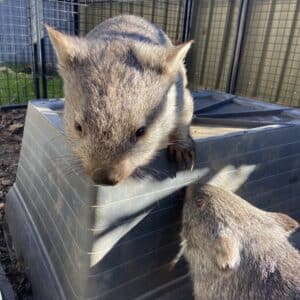
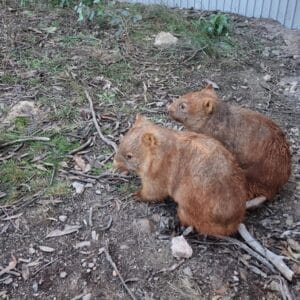
Left: Wombat buddies cared for by LAOKO member and HSI Australia grant recipient Rebecca Cowan
Right: Buddies at Wildlife Land Trust sanctuary Wombat Stomp
3. Learning to burrow
As the wombat joey grows, they will need to start attending “burrowing school”. At this point, they will be living in a larger enclosure where they can get messy and dig up a storm. Burrowing is an essential skill for wombats, used to create and maintain a safe shelter for a home and to raise young. Wombats will not be released until they have fully conquered this skill. Sturdy enclosures are a must for confident and rambunctious wombats who may test out escape routes by digging under fences!


Young wombats between 10–12kg using burrows at Wildlife Land Trust sanctuary Docsden
4. Soft-release
Once wombats are showing signs of maturity and release is not far off, they can undergo “soft release” or “pre-release”. Wombats at this stage should be showcasing natural behaviours, be acclimated to weather conditions and grazing outdoors. Most of their daytime hours will be spent in a burrow, meaning they are essentially nocturnal. There will be minimal human contact from carers at this stage.
The “soft-release” method gives wombats a transition period before all human involvement ceases. Wombats will be given open access to the natural environment outside their enclosure for at least two weeks. However, they are still able to go back to the familiarity of their enclosure as they please. They will still be monitored and given fresh food and water daily.

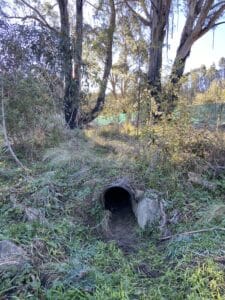
Soft release site at Wildlife Land Trust sanctuary Docsden
5. Release into the wild
Wombats ready for release must demonstrate that they are behaviourally and physically ready for life in the wild. A wombat ready for release will be 20–25kg, healthy, well-furred, confident at using and creating a burrow, able to find naturally available food and to navigate their environment independently. At this stage, it is time for the wombat to go off on their own and be with the wild counterparts of their species and to live in the wider ecosystem.
Of course, wildlife carers may experience mixed emotions at this stage, and it can be a time of nerves and sadness, but it may also spark a sense of pride knowing that the wombat is now ready to embark on their journey. It is always a hope that released wombats integrate into the breeding population and create successive generations whilst living out their whole future in the wild.
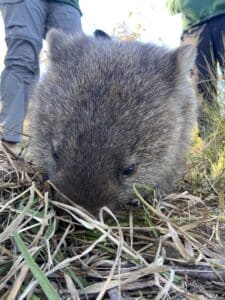 Bill – a fully rehabilitated wombat coming back for a visit at Wildlife Land Trust sanctuary Docsden
Bill – a fully rehabilitated wombat coming back for a visit at Wildlife Land Trust sanctuary Docsden
Do your part to save wombats on your land
Did you know that over 60 per cent of land in Australia is privately owned? This means that landowners have an incredible opportunity to make a difference for wildlife.
If you own a farm or bush block, you can provide habitat for wombats by making wombat-friendly gates, growing native grass species and simply offering them a safe place to live.
To get started, join the Wildlife Land Trust and become part of a movement to save wildlife on your land or visit our blog to learn other ways you can help wombats.


